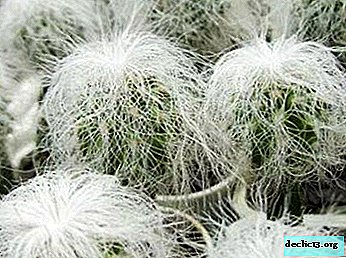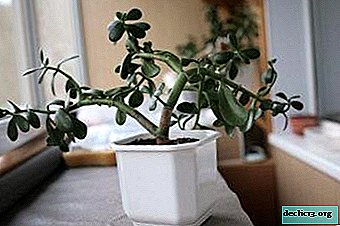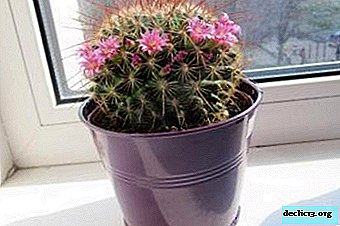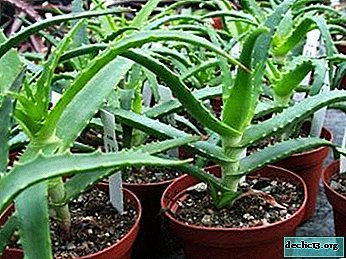Original cephalocereus: species description and flower care

The original appearance of cephalocereus, as a rule, makes it the center of the composition of succulents.
Reminiscent of a fluffy white cloud, the cactus is a long-liver and, subject to all conditions of care, can become an interior decoration for many years.
From this article you will learn about the nuances of care and reproduction of cephalocereus both in the open ground and at home. And also talk about what diseases and pests can infect this plant and what to do in such cases.
Botanical Description and Geography
Cephalocereus (Cephalocereus) in the people also called "the head of an old man" - These are columnar cacti, native to Central Mexico, where they grow in the southern regions on warm limestone slopes. These cacti are also found in Ecuador and in the eastern regions of Brazil.
In nature, their height can reach fifteen meters, home representatives do not grow more than 35 cm.The stem of these plants has well-developed ribs, the number of which in an adult cephalocereus reaches thirty. Areoles are often located and densely, in addition to spines, long white hairs grow from them.
The central spines are stiff, needle-shaped, reaching 4 cm in length. The trunk of the plant is gray-green in color, the thorns are yellowish or light brown. The flowers are funnel-shaped, cream or yellowish, with a diameter of up to five centimeters.
Important! In some species, a special organ is formed - cephaly. It looks like a part of the stem with weakly pronounced ribs and modified areoles covered with bristles and hairs. It is on them that buds, flowers and fruits are formed.Popular species and varieties (Cephalocereus)
Senile (Senilis)
Cactus, covered with thick and long, up to ten centimeters, hairs, which give it a resemblance to a gray beard. Hence the nickname "Head of the old man."

Pilozocereus herma (Pilosocereus hermii)
The plant is pubescent at the top of the stem, in the flowering zone. Sometimes pubescence appears on the sides of a thick, columnar, slightly branching stem. The cactus has wide ribs covered with densely spaced areoles.

Thick-billed (P. pachycladus)
The pubescence of this species is located in the upper areola. The columnar stalk of the young plant has a light blue color, consists of six ribs with bundles of thin spines in densely spaced areoles (are there cacti without spines?).

Pylozocereus Fulvilanatus (Pilosocereus fulvilanatus)
The plant is stunted and has a thin stem of a bluish-green hue with a waxy coating. The difference between this species and others is that its processes are located at the base.

Nisandesis (Nizandensis)
The species was named after its place of origin - Nisanda (Mexico). Cactus with small, straight, low ribs, with densely spaced areoles. With age, the lower part of the stem loses its hairline. The flowers are cream, funnel-shaped.

How to care at home?
- Temperature. The flower grower needs to be puzzled by observing the temperature regime for cephalocereus only in winter. During the rest period, from October to April, you need to maintain the temperature no higher than 10-15 degrees. At other times, the usual room temperature is quite comfortable for the plant.
- Watering. Watering should be carried out with warm water and be very scarce. As the soil dries thoroughly. During the rest period, watering is completely excluded. It is necessary to ensure that water does not get on the cactus itself, as this will lead to coalescence of the hairs.
- Shine. The more light the cephalocereus receives, the better. This plant is protected from burns by hairs. If the cactus does not have enough sunlight, it will begin to retract, the hairs will become shorter and the plant will lose its decorative effect.
- Priming. Cephalocereus is suitable for a slightly acidic nutrient mixture, which contains clay soil and coarse sand in equal proportions. The soil must be moisture permeable. You can also use a substrate consisting of equal shares of turf, leaf and peat land with sand and fine brick chips.
- Pruning. The plant does not need forming clippings, due to very slow growth.
- Top dressing. Fertilizer should be applied from May to July.
It is best to use ready-made feeding for cacti with the addition of calcium components, which have a good effect on the condition of the hairs.
- Pot. The tank for growing cephalocereus should be deep and always with drainage holes. The width of the tank is determined by the size of the root system in a straightened form.
- Transfer.
- Young plants are transplanted every year or every other year, adults - every two years.
- Transplantation is carried out by the method of transshipment.
- The earthen ball removed from the old pot must be dry.
- The new tank is also filled with dry soil, a plant is placed in it along with an old earthen lump.
- The first watering is carried out no earlier than ten days later.
- Wintering. For a comfortable stay at rest, cephalocereus needs to provide a temperature of no higher than ten degrees. Compliance with this condition and ensuring the absence of drafts is the main guarantee of a successful wintering of the plant.
Features of outdoor care
In summer, the plant can be transplanted into the garden. The main care during this period will be to remove near growing weeds and regular inspection of fluffy hair. The abundant pubescence of this cactus contributes to the easy propagation of pests and makes it defenseless against parasite damage (read about furry cacti here).
Breeding
Seeds
 Sowing is carried out in the spring.
Sowing is carried out in the spring.- Pre-seeds are soaked for half an hour in a solution of potassium permanganate.
- After that, they are washed, dried and sown in containers with a substrate.
- The bowl is covered with glass and kept at a temperature of 25 degrees, daily opening for ventilation.
- At this time, exposure to the bright spring sun should be avoided.
- After a week, the soil can be moistened with a spray gun.
- When the first spines appear in the sprouts, they can be dived into a spacious container and watered with a pan.
Vaccinated
Cephalocereus can be grafted onto another columnar cactus, not only for reproduction, but also to accelerate growth.
- Vaccination is best done in late spring or early summer.
- As a stock (vaccinated cactus), you should choose a healthy, well-growing cactus.
- The crown of the rootstock is cut at a height of about fifteen centimeters.
- At the scion (cephalocereus), the lower part with roots is carefully cut.
- After cutting, the scion is immediately applied to the prepared stock, preventing it from drying out.
- The design must be well fixed, for this, a piece of cotton wool is applied to the crown of the scion and secured with elastic bands or ties crosswise, passing them under the pot.
- Grafted cacti should be placed in a warm, moist place and kept in a fixed state for 5-10 days.
Features of breeding in open ground
It is unlikely that it will be possible to propagate cephalocereus in the open ground, due to the fact that the main, seed method of reproduction, involves the procedure using small containers and indoor conditions.
Diseases and Pests
 Lack of proper care provokes the appearance of mealy worms and flat red ticks on the plant.
Lack of proper care provokes the appearance of mealy worms and flat red ticks on the plant.
Also cephalocereus may be affected by spider mites introduced from the street. To prevent infection, you need to spray the cactus twice a year with a special remedy for ticks.
Stagnant moisture can lead to rotting of the roots and death of the plant. It is contraindicated to feed cephalocereus with organic compounds, from this the cactus can become bald.
Similar flowers
Cephalocereus has an external resemblance to:
- Hildevinteroy.
- Kleistocactus (about Kleistocactus Strauss read here).
- Mikrantotsereusom.
- Espostoa.
- Haagerocereus.
In general, cephalocereus is considered to be an unpretentious plant, but this is not entirely true. In practice, it turns out that under the long hairs, stem defects are not noticeable, allowing timely diagnosis of care errors.

 Sowing is carried out in the spring.
Sowing is carried out in the spring.















